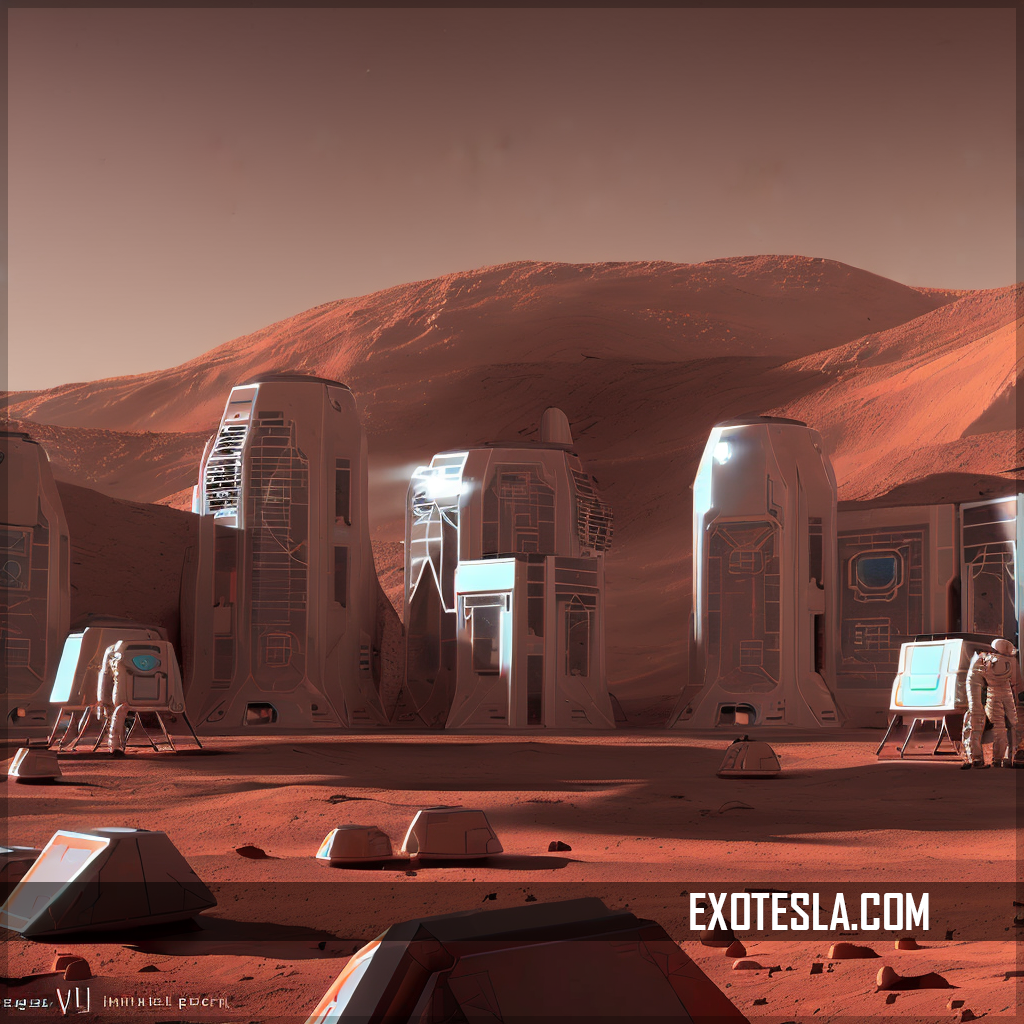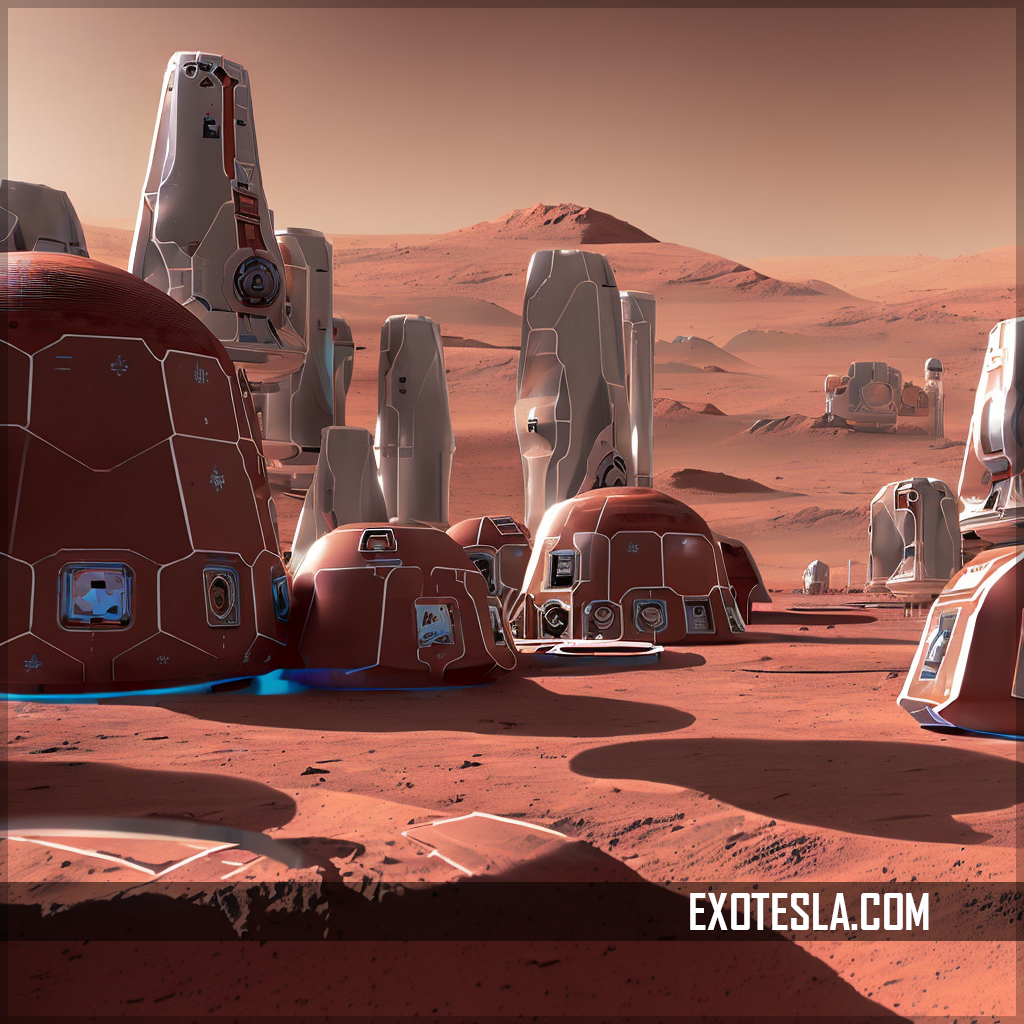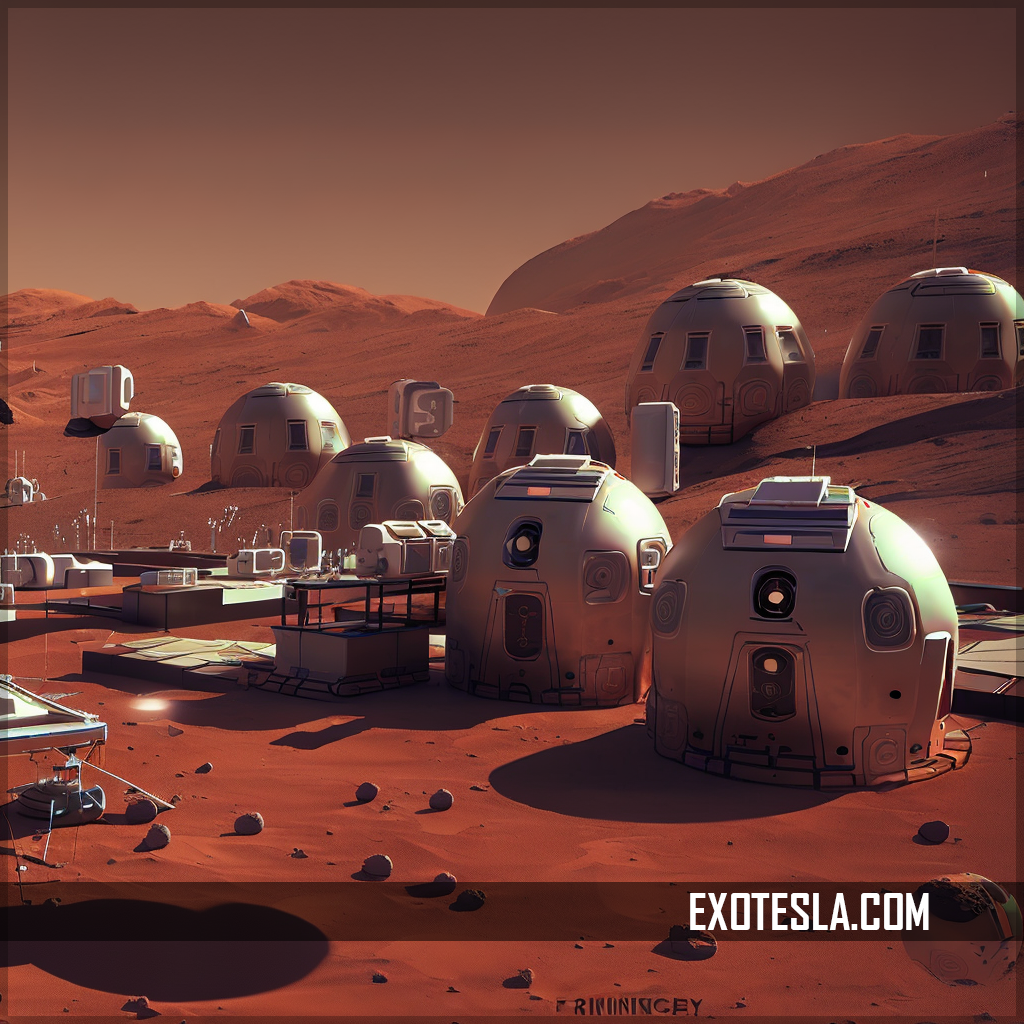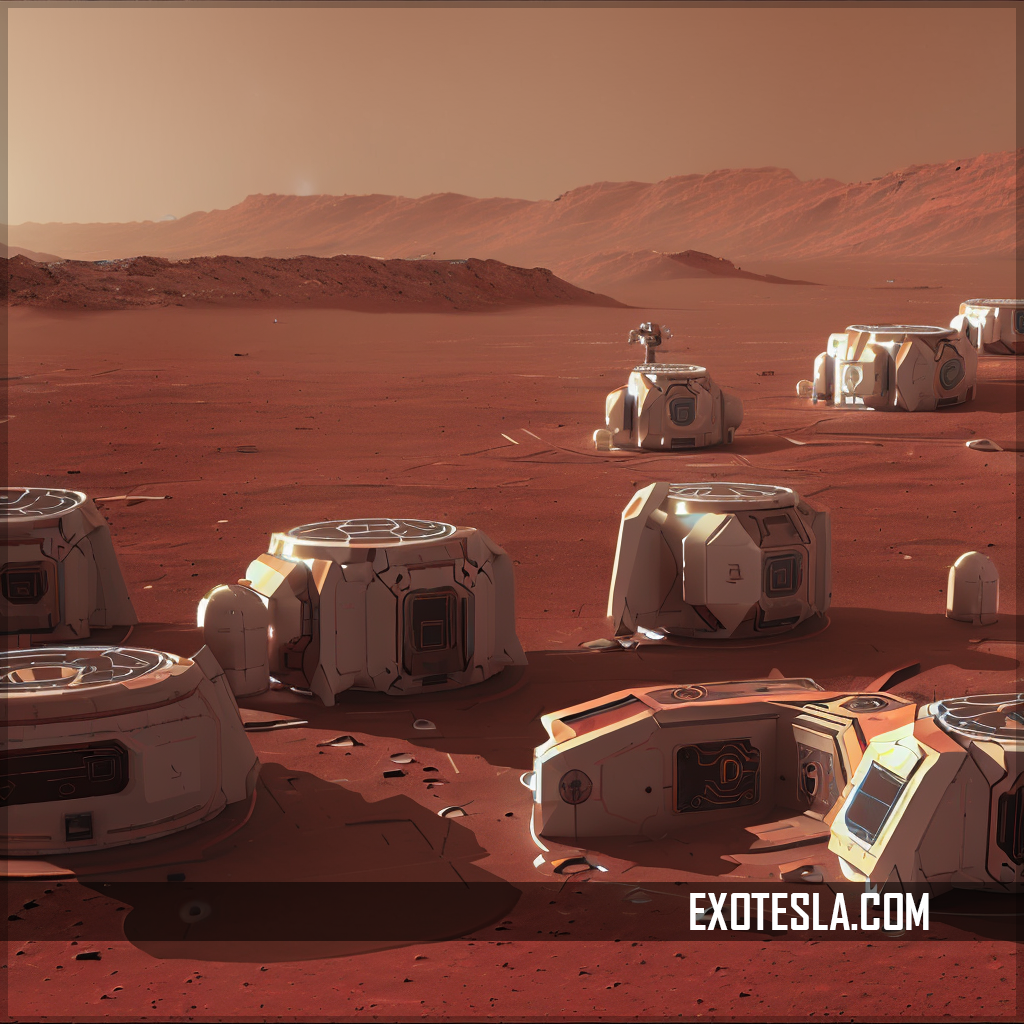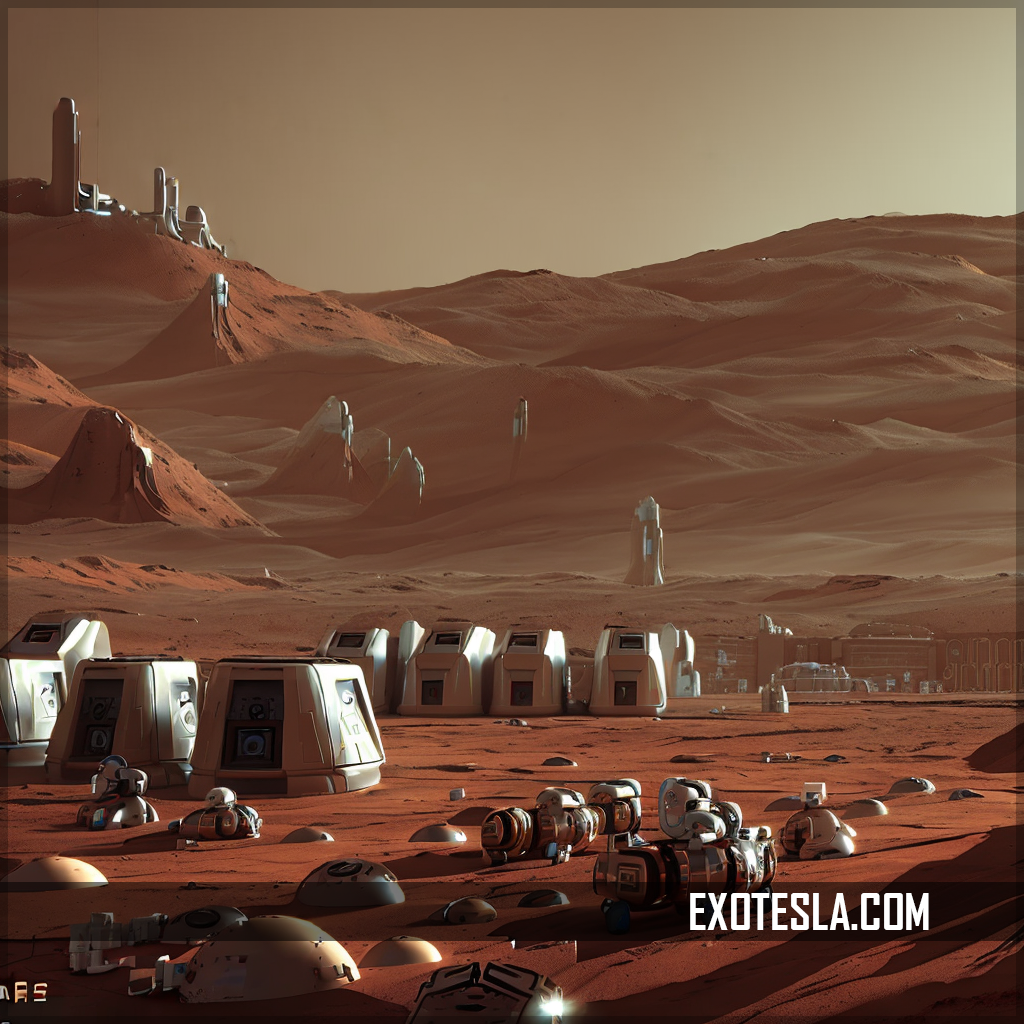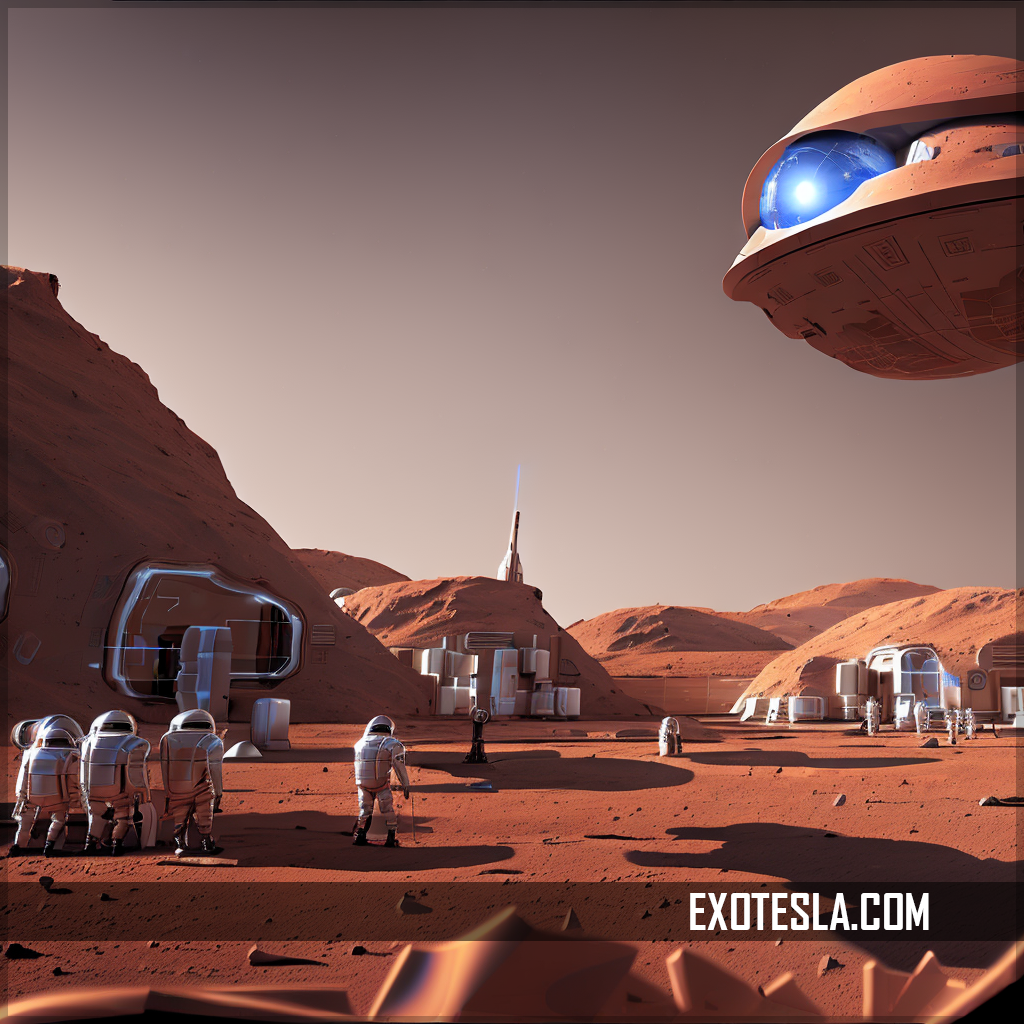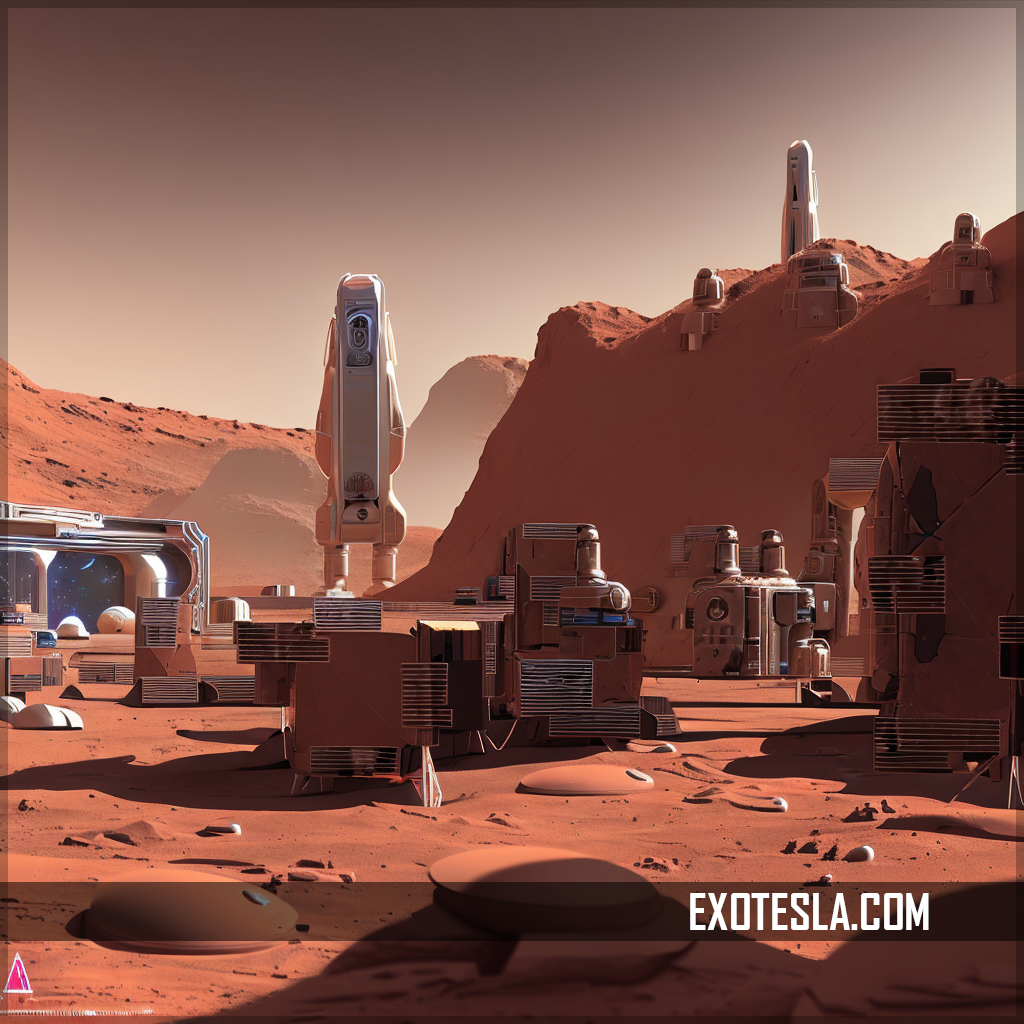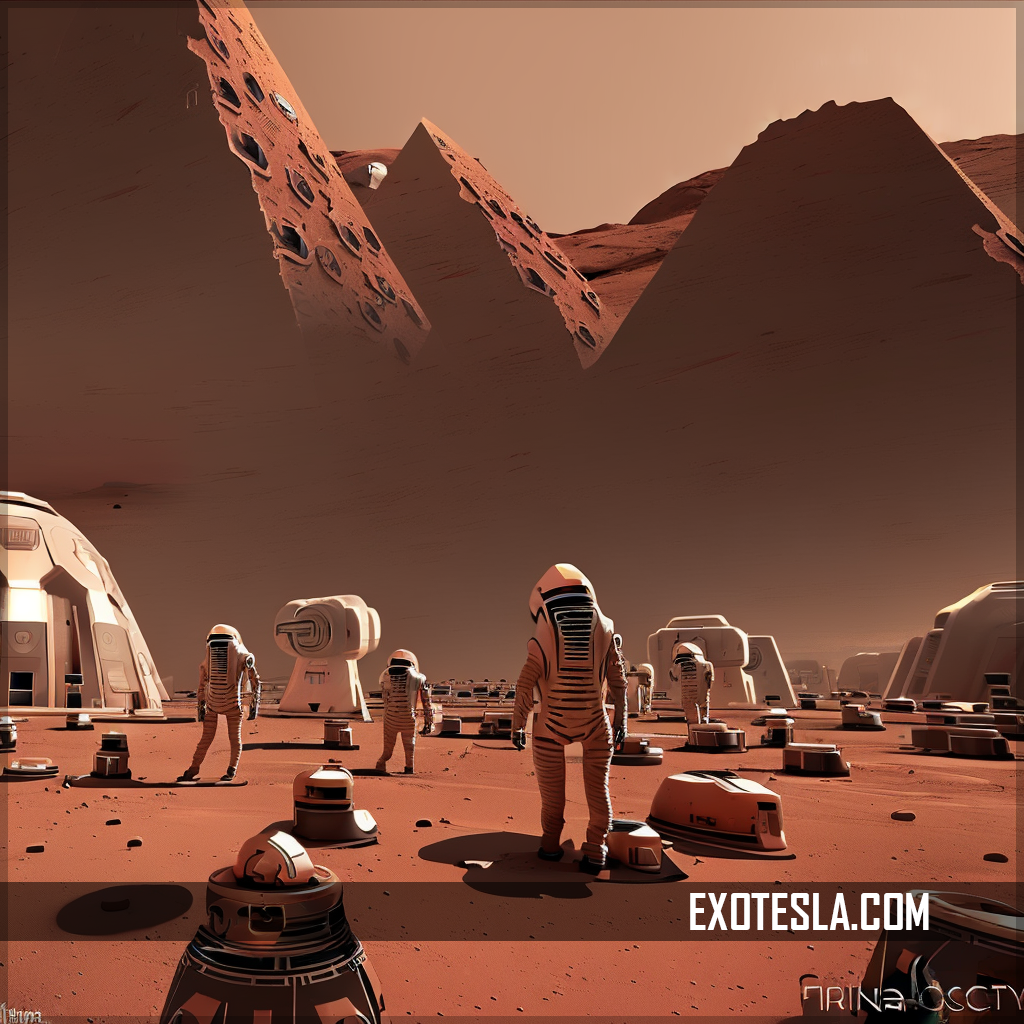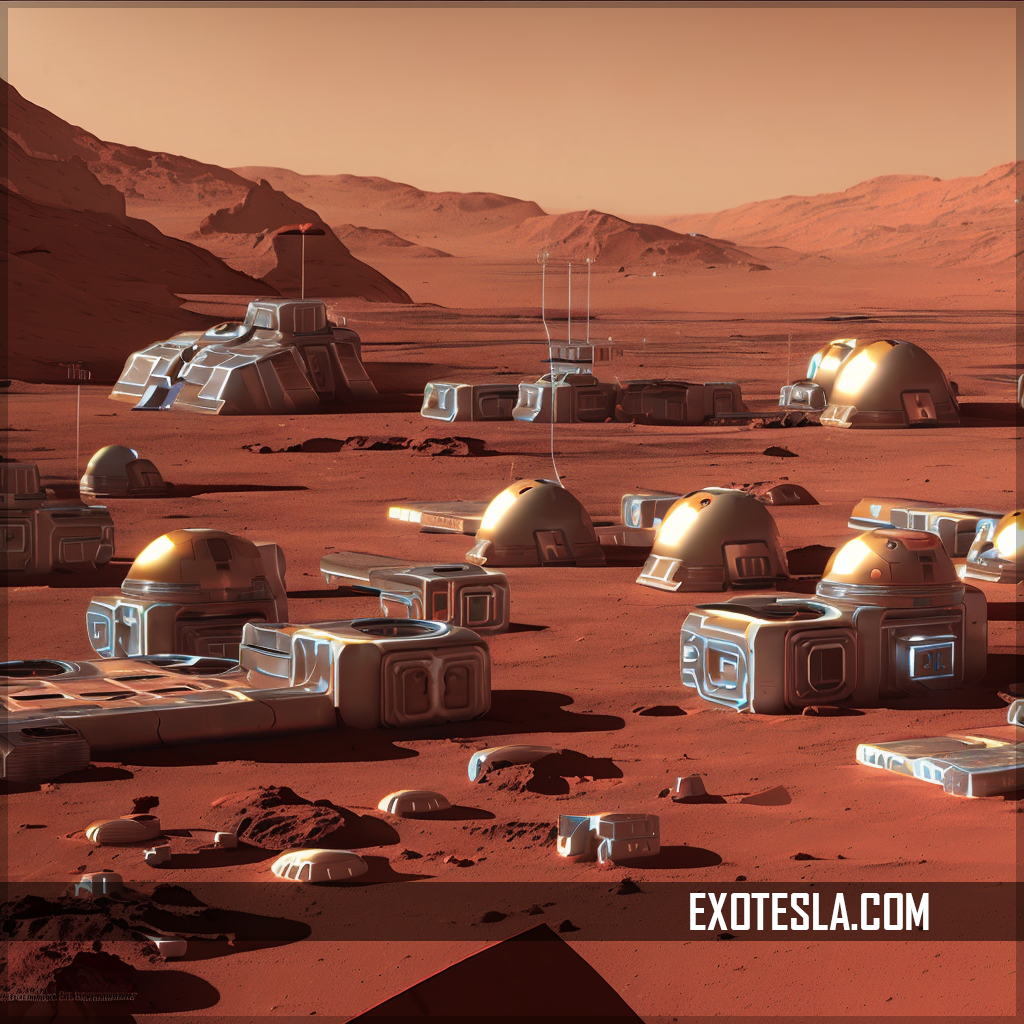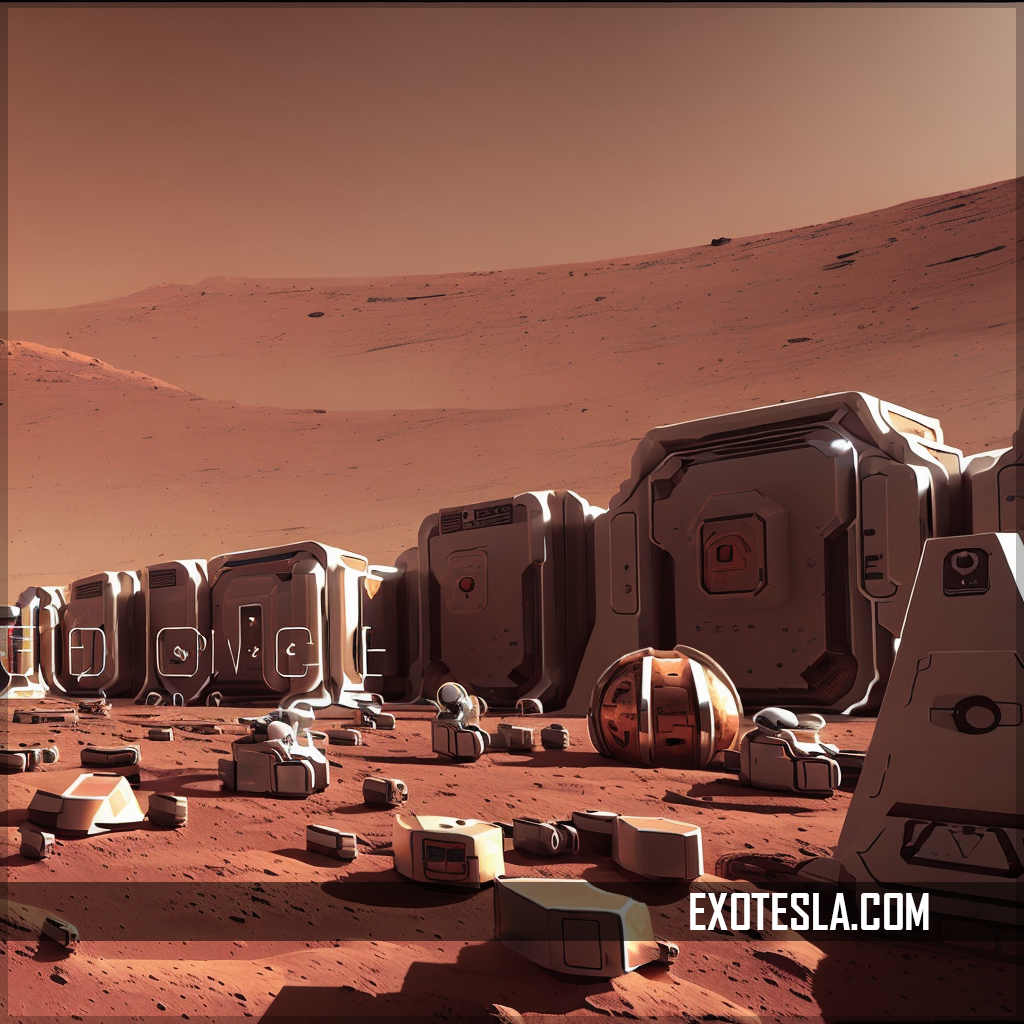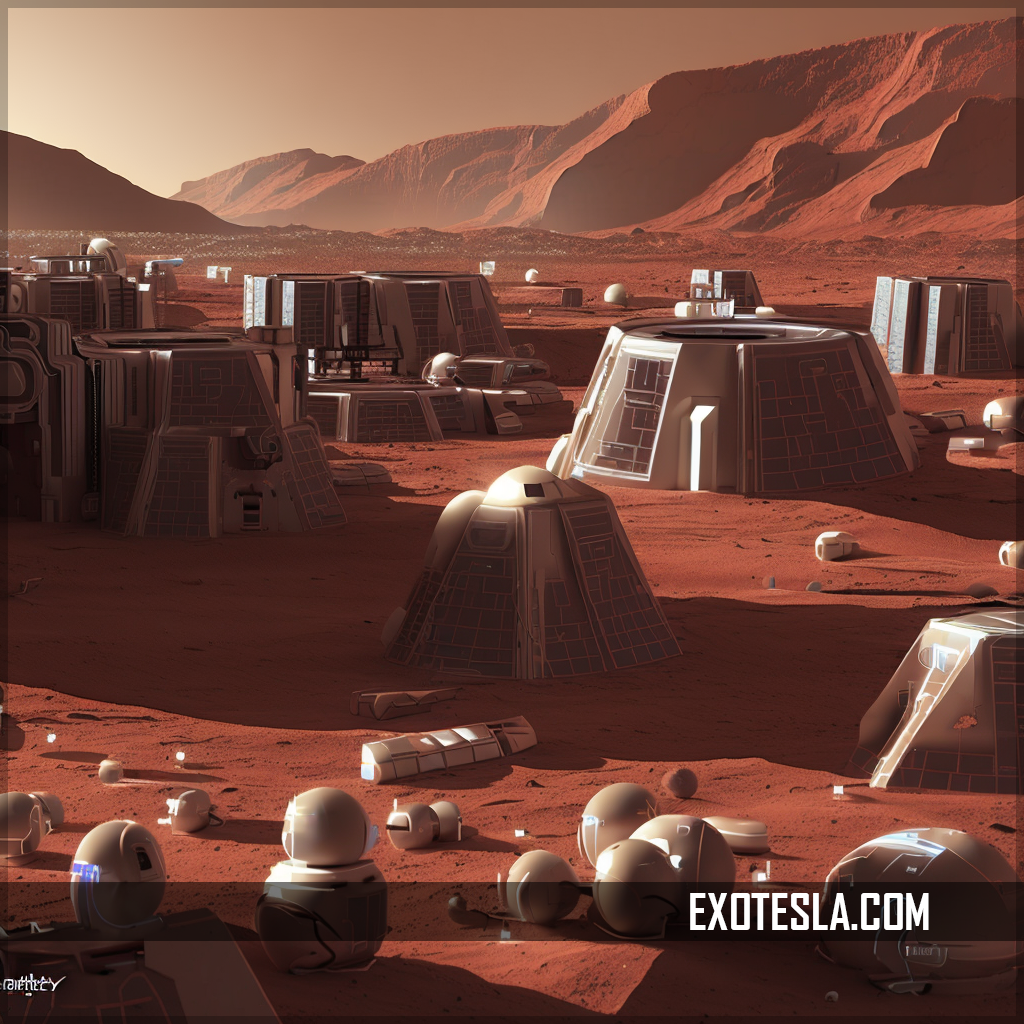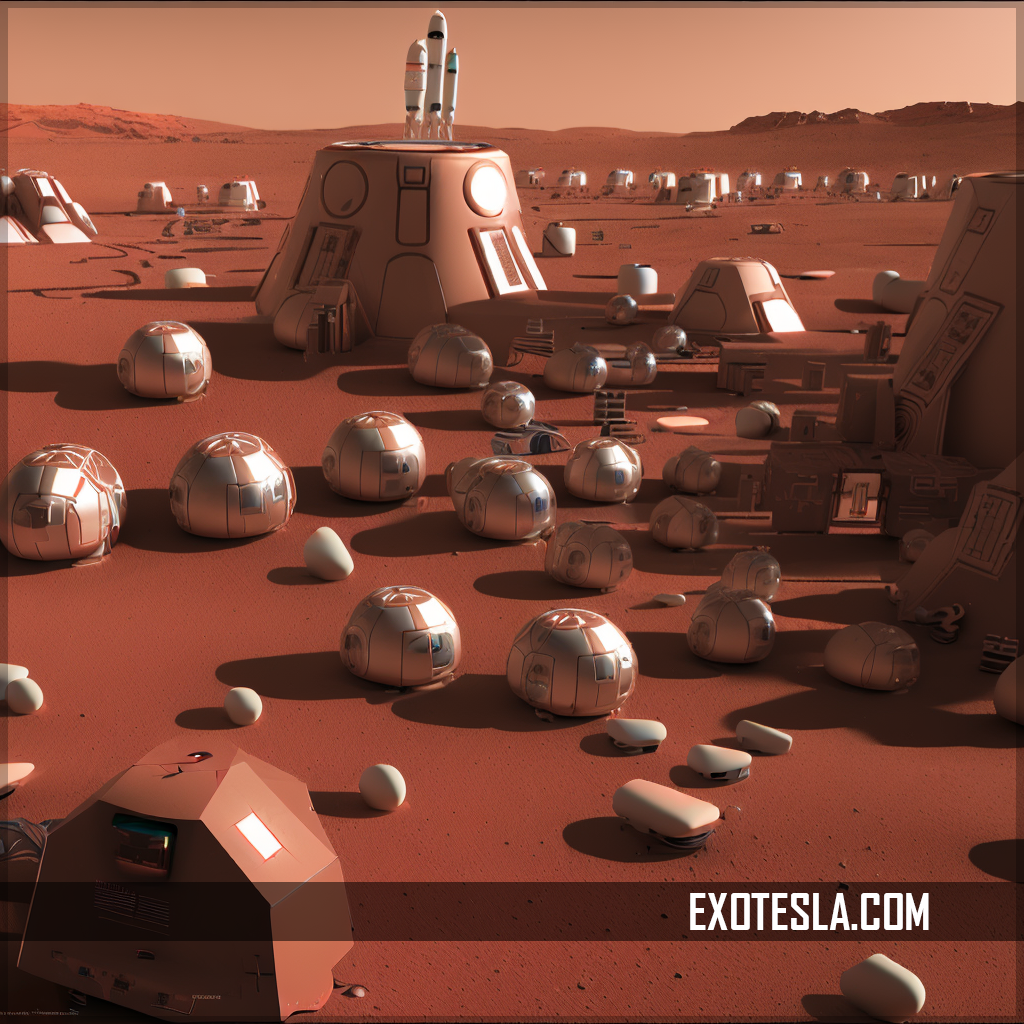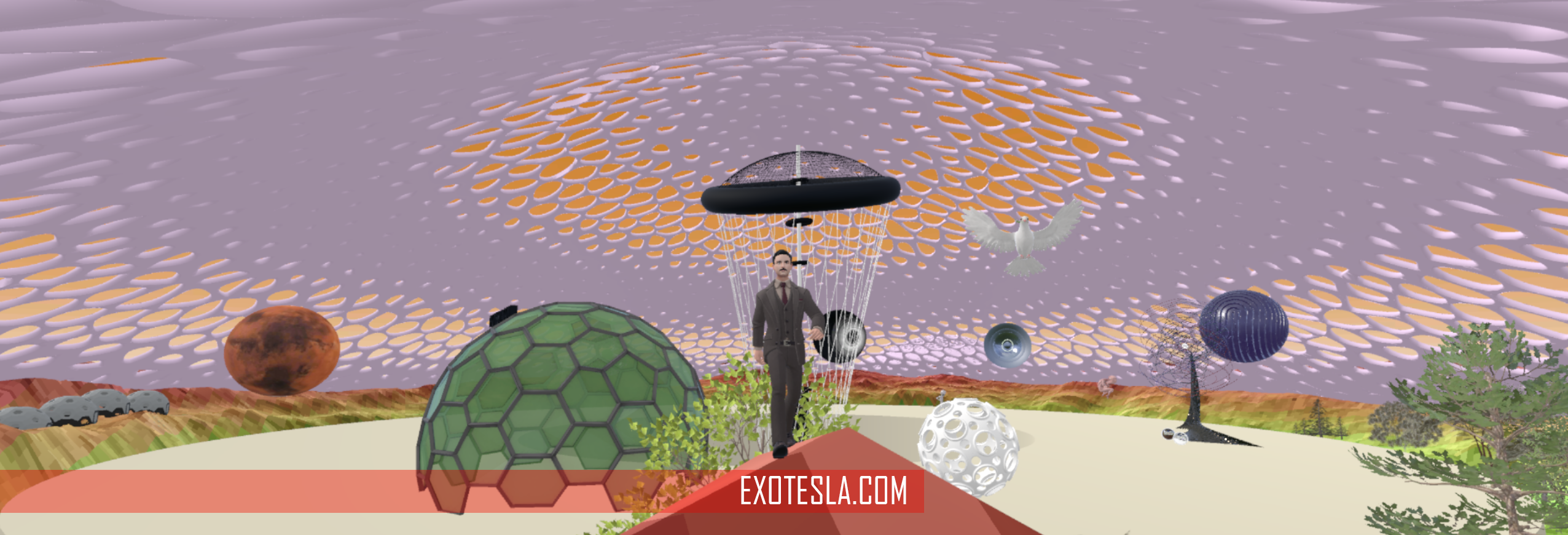 EXO TESLA | FREE ENERGY | AI | METAVERSE | SIMULATION | EXO POLITICS | TELEPATHY | PSI | ESP |
||
|
|
||
|
Sustainable and Equitable Mars Village. A Plan for a Blockchain-Based Economy with Free Energy, Basic Income, and Economic Exchange with Earth.
Blockchain-Based Economy: Implement a blockchain-based system to facilitate secure and transparent economic transactions within the Mars village. Blockchain technology can provide a decentralized ledger that records all economic activities, ensuring transparency, immutability, and trust in financial transactions. This system can enable residents of the Mars village to engage in trade, commerce, and financial interactions with each other and with external entities. Free Energy: Leverage sustainable energy sources, such as solar power, to provide free energy to the Mars village. By utilizing renewable energy, the Mars village can reduce its dependence on external energy sources and ensure a continuous and reliable energy supply. Free energy will not only support the daily operations of the village but also reduce the financial burden on its residents and promote sustainability. Basic Income Scheme: Establish a basic income scheme to provide every resident of the Mars village with a guaranteed minimum income. This income can be distributed to individuals or households, ensuring that everyone has access to the resources necessary for their basic needs. The basic income scheme will promote economic stability, alleviate poverty, and empower residents to engage in entrepreneurial activities, innovation, and personal growth. Economic Exchange with Earth, Orbital, and Asteroid Settlements: Foster economic exchange and collaboration with Earth, orbital settlements, and asteroid settlements. This can be achieved through trade agreements, resource sharing, and knowledge exchange. The Mars village can export its unique resources, such as minerals or scientific data, while importing goods and services that are not readily available on Mars. This economic exchange will create opportunities for growth, diversify the economic activities of the Mars village, and enhance its resilience and self-sufficiency. By implementing a blockchain-based economy, providing free energy, establishing a basic income scheme, and fostering economic exchange with other settlements, the Mars village can create a sustainable and equitable economic system. This system will promote fairness, incentivize innovation, and ensure the well-being and prosperity of its residents, while also fostering collaboration and interplanetary economic integration. Blockchain-Based Economy: Implement a blockchain platform specifically designed for the Mars village, allowing residents to conduct secure and transparent transactions. The blockchain can be tailored to accommodate the unique needs and challenges of the Martian environment, ensuring scalability, efficiency, and low transaction costs. Smart contracts can be utilized to automate and enforce various economic agreements and protocols, facilitating seamless and trustless interactions between individuals, businesses, and organizations within the Mars village. 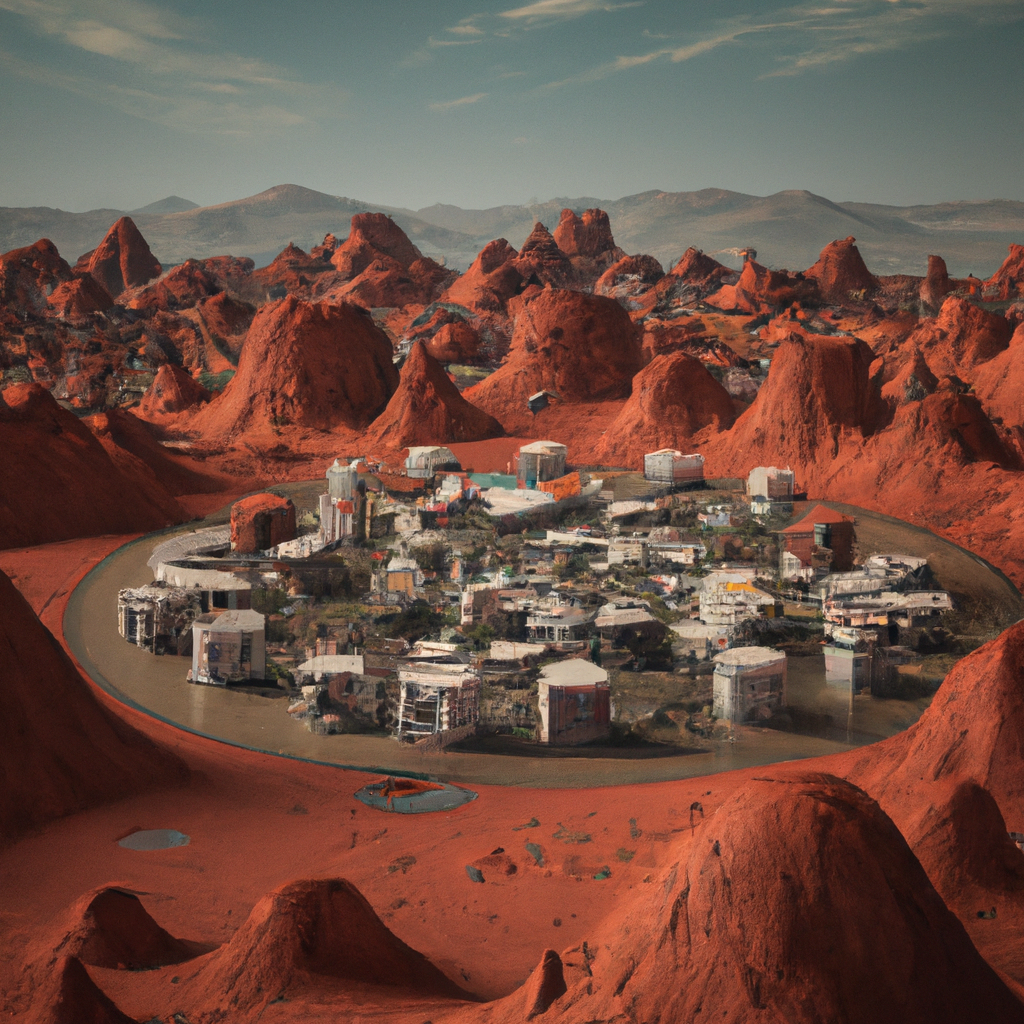 Resource Tracking and Management: Utilize the blockchain to track and manage the utilization of Martian resources. Each resource, such as water, minerals, or energy, can be assigned a digital token on the blockchain, representing its ownership and usage rights. This enables transparent tracking of resource extraction, consumption, and replenishment, ensuring sustainable resource management and preventing overexploitation. Smart contracts can automate resource allocation and distribution based on predefined rules and priorities, promoting fair access and utilization. Governance and Consensus Mechanism: Establish a decentralized governance framework for the Mars village, leveraging blockchain technology to ensure democratic decision-making and community involvement. Residents can participate in the governance process by voting on key matters, proposing initiatives, and contributing to policy-making discussions. A consensus mechanism, such as proof-of-stake or delegated proof-of-stake, can be employed to validate and secure the blockchain network, ensuring its integrity and resilience. Interplanetary Economic Exchange: Facilitate economic exchange between the Mars village and other settlements, including Earth, orbital stations, and asteroid settlements. Smart contracts can be utilized to enable secure and automated cross-settlement transactions, ensuring transparency and accountability. Trade agreements can be established, allowing the exchange of goods, services, and knowledge between the Martian community and other spacefaring entities. This exchange can stimulate economic growth, encourage innovation, and foster collaboration and cultural exchange between different settlements. Financial Inclusion and Empowerment: The blockchain-based economy can promote financial inclusion and empowerment within the Mars village. Through the use of digital wallets and blockchain-based financial services, residents can securely store, manage, and transact their funds. Access to financial services, such as loans, insurance, and investment opportunities, can be extended to all residents, enabling them to pursue entrepreneurial ventures, education, and personal development. This fosters a dynamic and inclusive economy that empowers individuals and promotes social mobility. By implementing these additional measures, the Mars village can establish a robust and sustainable economic system that prioritizes transparency, fairness, and self-sufficiency. The blockchain technology, combined with free energy, a basic income scheme, and interplanetary economic exchange, lays the foundation for an equitable and prosperous Martian community, fostering collaboration, innovation, and long-term growth.  Commercial Opportunities for a Mars Settlement: Science, Technology, and Products for Earth-Based Companies and Space Agencies
Scientific Research: Mars offers a unique environment for scientific exploration and discovery. Earth-based companies and space agencies can collaborate with the Mars settlement to conduct research in fields such as astrobiology, geology, climate science, and human health. This collaboration can lead to valuable insights and advancements that contribute to our understanding of the universe and benefit various industries on Earth. Technology Development: The challenges of living on Mars necessitate the development of innovative technologies. Earth-based companies can partner with the Mars settlement to co-develop technologies specifically designed for the Martian environment. This includes advancements in areas such as life support systems, sustainable energy generation, resource utilization, robotics, 3D printing, and communication systems. These technologies can have applications beyond Mars and find commercial use on Earth, enhancing various industries and improving sustainability practices. Aerospace and Transportation: Establishing a Mars settlement requires efficient and reliable aerospace systems for transportation between Earth and Mars. Companies specializing in aerospace engineering, spacecraft manufacturing, propulsion systems, and space logistics can collaborate with the Mars settlement to design, build, and operate spacecraft and launch systems. These partnerships can drive advancements in space transportation technology, benefitting both interplanetary missions and Earth-based space exploration endeavors. Materials and Manufacturing: The Mars settlement will require a range of materials and products for construction, infrastructure development, and daily living. Companies involved in materials science, manufacturing, and construction can explore opportunities to provide specialized materials, equipment, and manufacturing technologies suitable for the Martian environment. This includes advanced construction techniques, lightweight and durable materials, additive manufacturing solutions, and sustainable resource utilization processes. Communication and Information Systems: Reliable communication systems are essential for real-time or near-real-time communication between the Mars settlement and Earth. Earth-based companies can collaborate to develop high-bandwidth communication networks, satellite systems, data management and analysis tools, and cybersecurity solutions tailored for interplanetary communication. These advancements can not only support the Mars settlement's needs but also improve global communication infrastructure and connectivity on Earth. 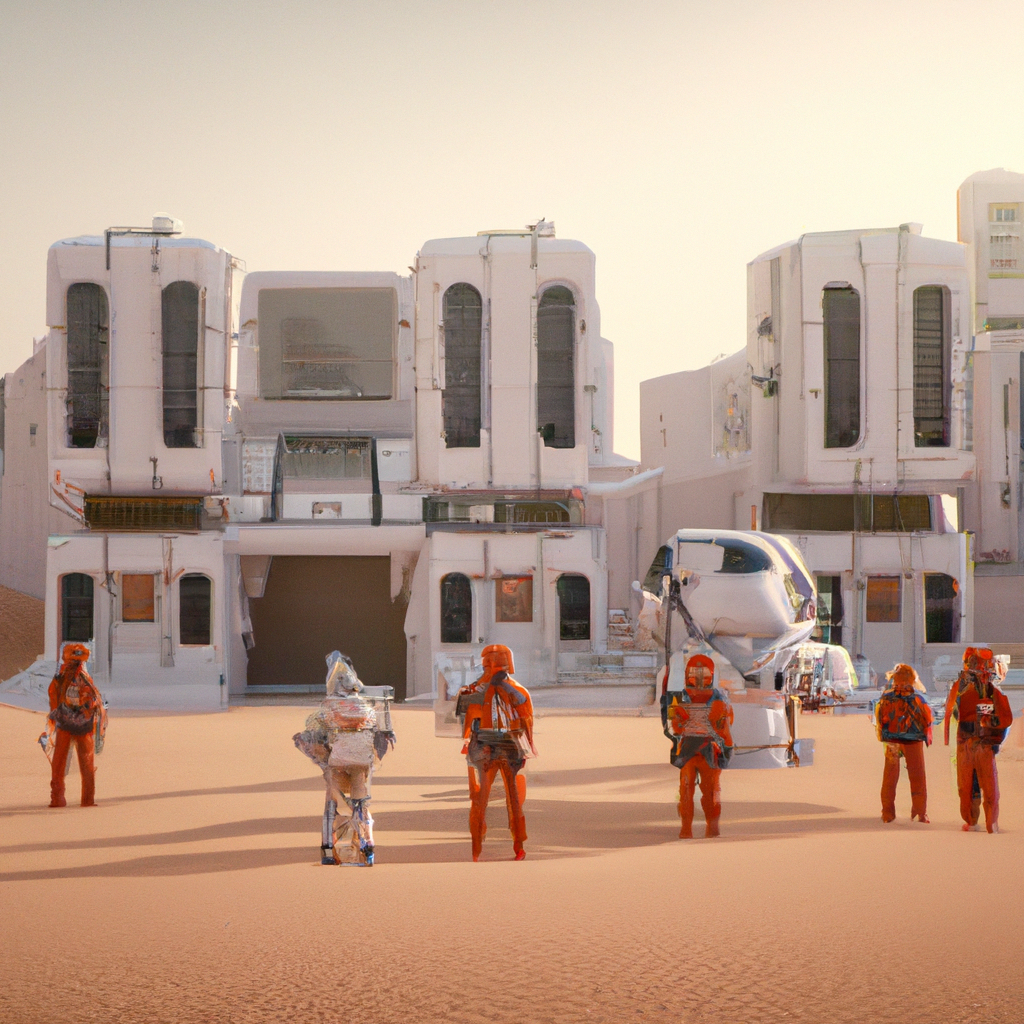 Space Tourism and Entertainment: As Mars exploration progresses, there is potential for space tourism and entertainment industries to emerge. Earth-based companies can play a role in designing and operating spacecraft for tourist missions, developing immersive experiences that simulate Mars exploration, and creating entertainment content related to space travel and colonization. These ventures can cater to the public's interest in space and contribute to the growth of the space tourism sector. Resource Extraction and Mining: Mars possesses valuable resources, such as water ice, minerals, and metals, which can be utilized for local consumption or exported back to Earth. Earth-based companies specializing in resource extraction, mining, and refining can collaborate with the Mars settlement to develop efficient and sustainable methods of extracting and processing these resources. This partnership can lead to the establishment of Martian resource industries, providing raw materials for manufacturing and supporting future space exploration missions. Agriculture and Life Support Systems: Sustainable food production is crucial for long-term habitation on Mars. Earth-based companies experienced in agriculture, hydroponics, vertical farming, and controlled environment systems can contribute their expertise to develop advanced farming methods suitable for Martian conditions. Collaboration with the Mars settlement can result in the creation of efficient and automated food production systems, optimized nutrient delivery, and crop varieties adapted to the Martian environment. These advancements can have applications on Earth, particularly in regions with limited arable land or challenging environmental conditions. Environmental Monitoring and Analysis: Continuous monitoring and analysis of the Martian environment are essential for understanding its dynamics, identifying potential hazards, and optimizing resource utilization. Earth-based companies specializing in remote sensing, data analysis, and environmental monitoring can partner with the Mars settlement to provide advanced instruments, satellite systems, and data analytics platforms. This collaboration can enhance our knowledge of Mars' atmosphere, weather patterns, geological activity, and potential biological indicators, enabling better decision-making and facilitating further scientific discoveries. Health and Biomedical Research: The effects of long-duration space missions and exposure to the Martian environment on human health require in-depth research and development. Earth-based pharmaceutical companies, biomedical research institutions, and healthcare providers can collaborate with the Mars settlement to study the physiological and psychological impacts of living on Mars. This collaboration can lead to the development of innovative medical technologies, personalized healthcare solutions, and novel therapies for space travelers. The insights gained can also have applications on Earth, contributing to advancements in healthcare and well-being. Education and Outreach: The exploration and colonization of Mars offer significant educational and outreach opportunities. Earth-based educational institutions, science centers, and media organizations can partner with the Mars settlement to develop educational programs, documentaries, and immersive experiences that engage and inspire the public. These initiatives can foster scientific literacy, promote STEM education, and cultivate a sense of wonder and curiosity about space exploration, benefiting society as a whole. By capitalizing on these commercial opportunities and fostering collaboration between Earth-based companies, space agencies, and the Mars settlement, we can accelerate technological advancements, expand scientific knowledge, stimulate economic growth, and inspire future generations to explore and push the boundaries of human potential. The mutual exchange of expertise, resources, and products between Earth and Mars can pave the way for a sustainable and prosperous interplanetary future. 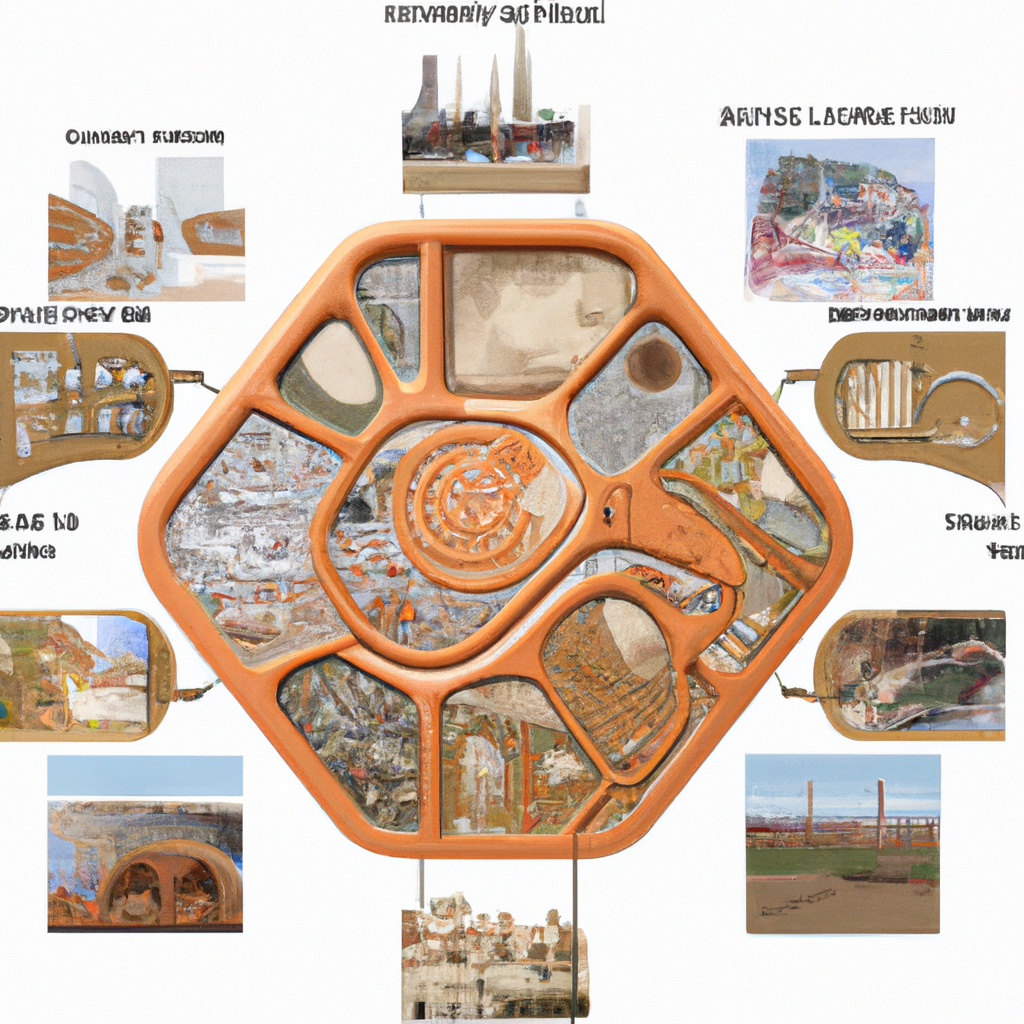 Parameters for Mars village development location selection
When selecting possible locations for Mars village development, several parameters need to be considered. Here are some key factors to evaluate: Geology and Topography: The geology and topography of a potential site play a vital role in determining its suitability for a Mars village. Flat and stable terrains with minimal slopes are preferable for ease of construction and deployment of infrastructure. Additionally, locations with accessible resources such as water ice, minerals, and regolith can facilitate in-situ resource utilization and support the sustainability of the settlement. Solar Insolation: Mars receives sunlight, which can be harnessed as a source of energy for power generation. Hence, selecting a location with ample solar insolation is crucial to ensure a reliable and sustainable energy supply for the village. Areas with fewer obstructions, such as tall cliffs or crater rims, are ideal for maximizing solar exposure. Water Availability: Water is a critical resource for sustaining life and supporting various activities on Mars. Therefore, identifying areas with potential water sources, such as subsurface ice deposits or regions with higher water vapor content in the atmosphere, is important. Proximity to water sources reduces the reliance on water transported from Earth and enables the development of local water extraction and purification systems. Environmental Conditions: Mars is known for its extreme environmental conditions, including low atmospheric pressure, low temperatures, and high radiation levels. Choosing a location that minimizes exposure to harsh elements and provides natural shielding, such as selecting a site in a crater or near natural formations, can enhance the safety and habitability of the Mars village. Communication and Navigation: Establishing reliable communication links with Earth and facilitating interplanetary navigation are vital for the success of a Mars settlement. Therefore, selecting a location that ensures line-of-sight communication with Earth-based antennas and favorable orbital dynamics for communication satellites can optimize the efficiency and effectiveness of communication systems. 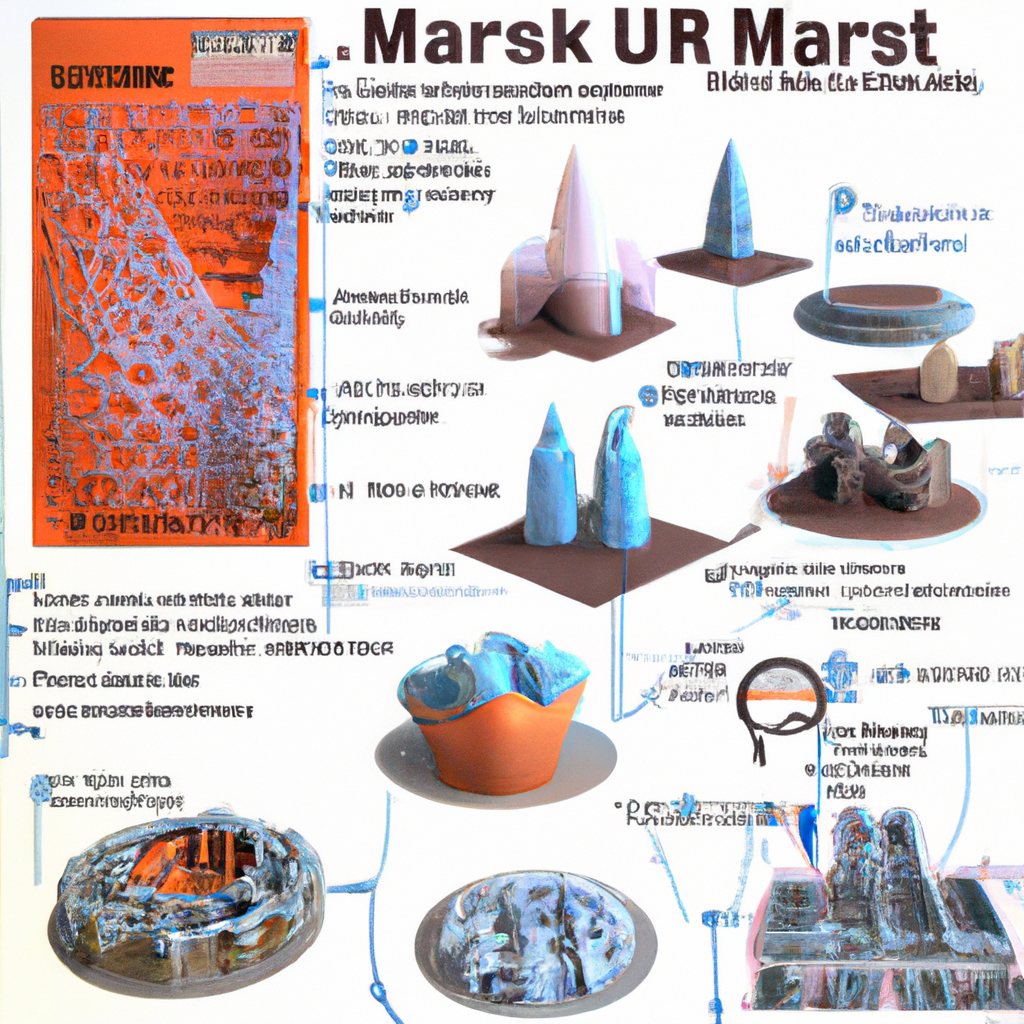 Scientific and Exploration Value: Mars offers significant scientific and exploration opportunities. Choosing a location that provides access to interesting geological features, potential sites for future scientific research, or areas of high astrobiological interest can facilitate groundbreaking discoveries and contribute to our understanding of the Red Planet's history and potential for past or present life. By evaluating these parameters and conducting detailed surveys, mapping, and reconnaissance missions, potential locations for a Mars village can be identified. It is important to consider a holistic approach that balances multiple factors to ensure the long-term sustainability, safety, and scientific value of the chosen site. 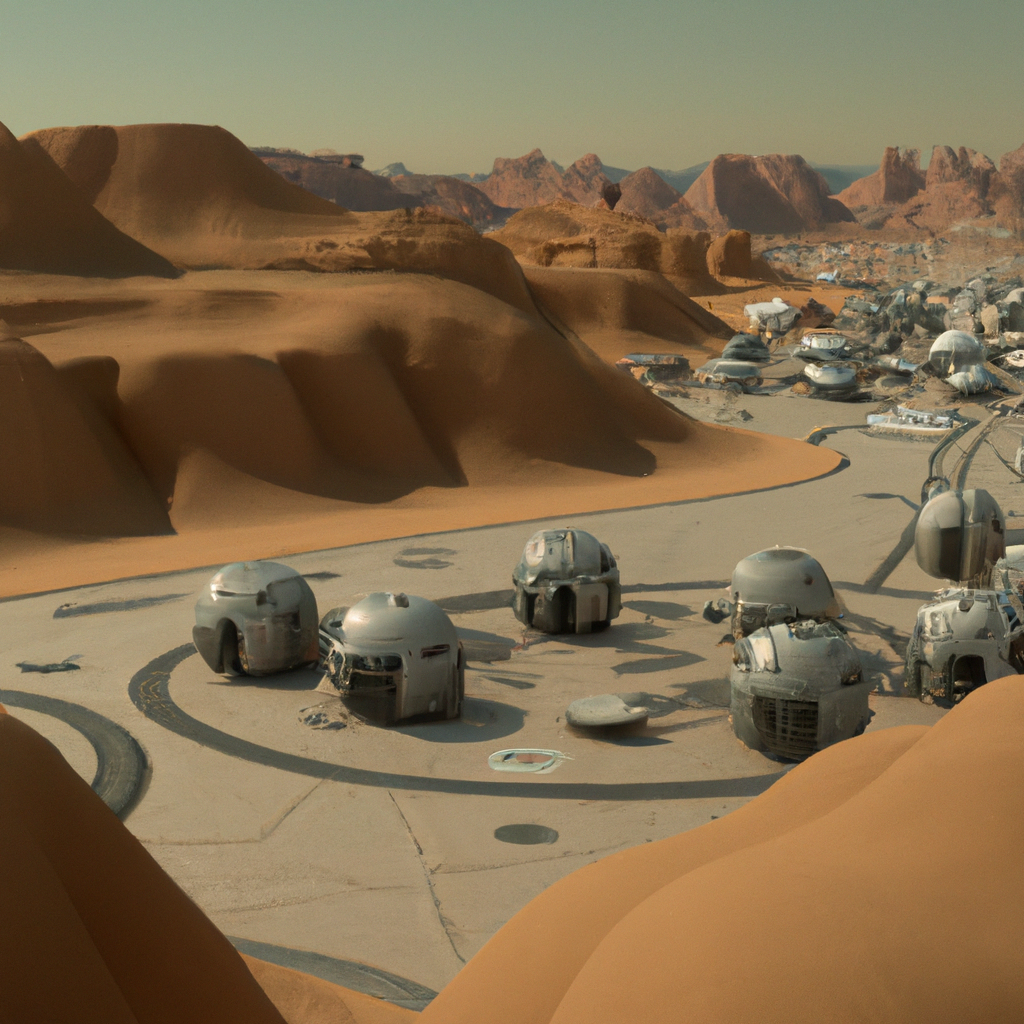 Example locations for a Mars village development
Elysium Planitia: Description: Elysium Planitia is a vast plain located near the equator of Mars. It offers a relatively flat and stable terrain, making it suitable for construction and infrastructure development. The region has a moderate amount of solar insolation, providing ample sunlight for power generation. Elysium Planitia is also believed to have subsurface water ice deposits, which can support water extraction and utilization efforts. Its proximity to the equator allows for better communication with Earth-based antennas, ensuring reliable and efficient communication links. Valles Marineris: Description: Valles Marineris is a massive canyon system on Mars, stretching over 4,000 kilometers in length. Although it is a challenging environment, Valles Marineris presents unique opportunities for scientific research and exploration. The canyon walls offer natural shielding from radiation, providing enhanced protection for the settlement. Additionally, the presence of diverse geological features and the possibility of accessing ancient rock layers make Valles Marineris a prime location for studying Mars' geological history. However, the rugged terrain and steep slopes may pose challenges for construction and infrastructure development. Hellas Planitia: Description: Hellas Planitia is one of the largest impact basins on Mars, located in the southern hemisphere. Its low elevation and large surface area provide favorable conditions for the collection of atmospheric gases, which can be utilized for various purposes, including the production of breathable air and propellant. The region also exhibits potential for subsurface ice deposits, supporting water resource utilization. Hellas Planitia's lower latitudes offer longer daylight hours, optimizing solar energy generation. However, the basin's southern location may present communication challenges due to the oblique angle of communication with Earth. Utopia Planitia: Description: Utopia Planitia is a flat plain located in the northern hemisphere of Mars. It is known for its rich deposits of water ice, making it an excellent candidate for water extraction and utilization. The region's relatively low altitude provides advantages in terms of atmospheric pressure and radiation protection. Utopia Planitia offers a favorable environment for landing and deploying robotic missions, facilitating infrastructure development. Its proximity to the Martian polar ice caps offers potential scientific research opportunities related to climate and environmental studies. Acidalia Planitia: Description: Acidalia Planitia is a large plain located in the northern hemisphere of Mars. It offers a relatively smooth and flat terrain, making it suitable for construction and infrastructure development. The region is believed to have subsurface ice deposits, providing a potential water resource for the settlement. Acidalia Planitia also benefits from its proximity to the Martian northern polar ice cap, which could support scientific research related to ice dynamics and climate studies. The plain's moderate latitude allows for better communication with Earth-based antennas. Argyre Planitia: Description: Argyre Planitia is a prominent impact basin located in the southern hemisphere of Mars. It features a deep basin with a central peak and a surrounding ring of rugged terrains. The basin's unique geological features offer opportunities for scientific exploration and research into Mars' ancient history. Argyre Planitia is also known for its potential water resources, with indications of subsurface ice deposits. However, the region's high latitude may result in shorter daylight hours and colder temperatures compared to equatorial regions.  Olympus Mons: Description: Olympus Mons is the largest volcano and one of the most prominent features on Mars. Located near the Martian equator, it offers a relatively stable and low-risk geological environment. The volcano's shield-like shape and the surrounding lava plains provide opportunities for construction and infrastructure development. Olympus Mons also benefits from its proximity to Valles Marineris, which can facilitate access to geological formations and potential resources. However, the volcanic region may require careful monitoring and mitigation strategies for potential volcanic activity. Tempe Terra: Description: Tempe Terra is a region in the northern hemisphere of Mars, characterized by a diverse landscape of plateaus, mesas, and valleys. The region exhibits geological features that are of great interest to scientific research, including ancient riverbeds and outflow channels. Tempe Terra offers opportunities for studying Mars' past water history and potential habitability. The region's relatively moderate latitude and proximity to the Martian equator provide advantages in terms of solar energy availability. However, the rugged terrain may pose challenges for infrastructure development. These additional examples provide further insights into potential locations for a Mars village. Each location has its own geological characteristics, resource potential, and scientific research opportunities. Careful evaluation of these factors, along with considerations such as communication capabilities, environmental conditions, and accessibility, would be crucial in selecting the most suitable location for the Mars village.  Overview of Mars Village Settler Profiles
Scientific Settlers: Scientific settlers on Mars would primarily consist of researchers, scientists, and specialists from various fields such as astronomy, geology, biology, physics, and planetary sciences. Their main objective would be to conduct in-depth scientific investigations and experiments to expand our understanding of Mars and its potential for sustaining life. These individuals would contribute to the advancement of knowledge in areas like astrobiology, geophysics, climate studies, and the search for evidence of past or present life on Mars. Their expertise would be crucial in unlocking the mysteries of the Red Planet. Engineering and Technical Settlers: Engineering and technical settlers would play a vital role in the construction, maintenance, and operation of the Mars village's infrastructure. This group would include engineers, technicians, architects, and construction specialists who possess the skills necessary to build habitats, power generation systems, communication networks, life support systems, and other critical infrastructure. Their expertise would ensure the successful implementation and functioning of the various systems required for sustainable living on Mars. Medical and Health Professionals: Medical and health professionals would be essential for the well-being and care of the Mars village settlers. This group would include doctors, nurses, psychologists, and other healthcare specialists who can address the unique challenges associated with living in a harsh and isolated environment. They would be responsible for providing medical assistance, monitoring the physical and mental health of the settlers, and developing strategies to mitigate the effects of long-duration space travel and the Martian environment. Space Tourists: As space exploration advances, there is a possibility of including space tourists in Mars missions. These individuals would be civilians who have undergone rigorous training and preparation to visit Mars as part of a commercial venture or space tourism program. Space tourists would have the opportunity to experience life on Mars for a limited duration and participate in curated activities and scientific experiments under the guidance of experts. They would contribute to the cultural and economic aspects of the Mars village, while also gaining a unique perspective on space exploration. These different settler profiles would form a diverse and interdisciplinary community on Mars, with each group bringing their expertise and contributing to the overall success of the Mars village. Collaboration, knowledge sharing, and a spirit of exploration would be crucial for the development and sustainability of the human presence on Mars. 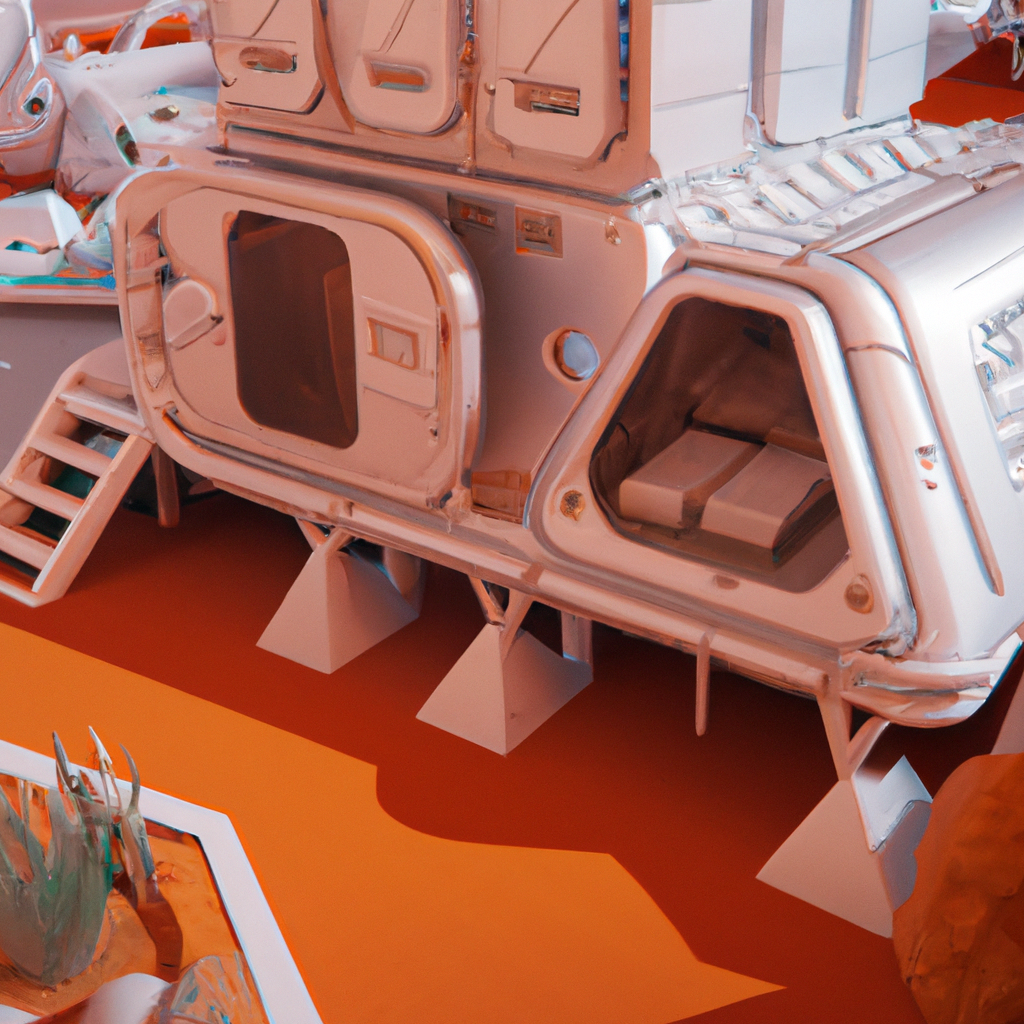 Parametric Architecture Development Plan: Leveraging In Situ Resource Utilization and Additive Manufacturing for the Mars Village
The development plan for the parametric architecture of the Mars village includes a focus on in situ resource utilization and additive manufacturing. In situ resource utilization involves utilizing the available resources on Mars, such as regolith (Martian soil), water ice, and minerals, to construct habitats and infrastructure. Additive manufacturing, also known as 3D printing, plays a crucial role in this process by enabling the on-site production of building materials and components. The first step in the development plan is to conduct a thorough assessment of the available resources on Mars. This involves identifying suitable locations for resource extraction, evaluating the composition and quality of the regolith, and locating potential sources of water ice. Advanced robotic systems and geological surveys will be employed to gather data and analyze the resources. Once the resources are identified, the next phase involves developing the necessary technologies and equipment for resource utilization and additive manufacturing. This includes designing and building robotic systems capable of mining and processing the regolith, extracting water ice, and refining minerals. The development of efficient extraction and processing techniques is essential to ensure the viability and sustainability of the resource utilization process. Simultaneously, additive manufacturing techniques will be developed and adapted to the Martian environment. Specialized 3D printers capable of utilizing Martian regolith or other locally available materials will be designed. These printers will be equipped with advanced robotics and automation systems to construct habitats, infrastructure components, and other necessary structures. 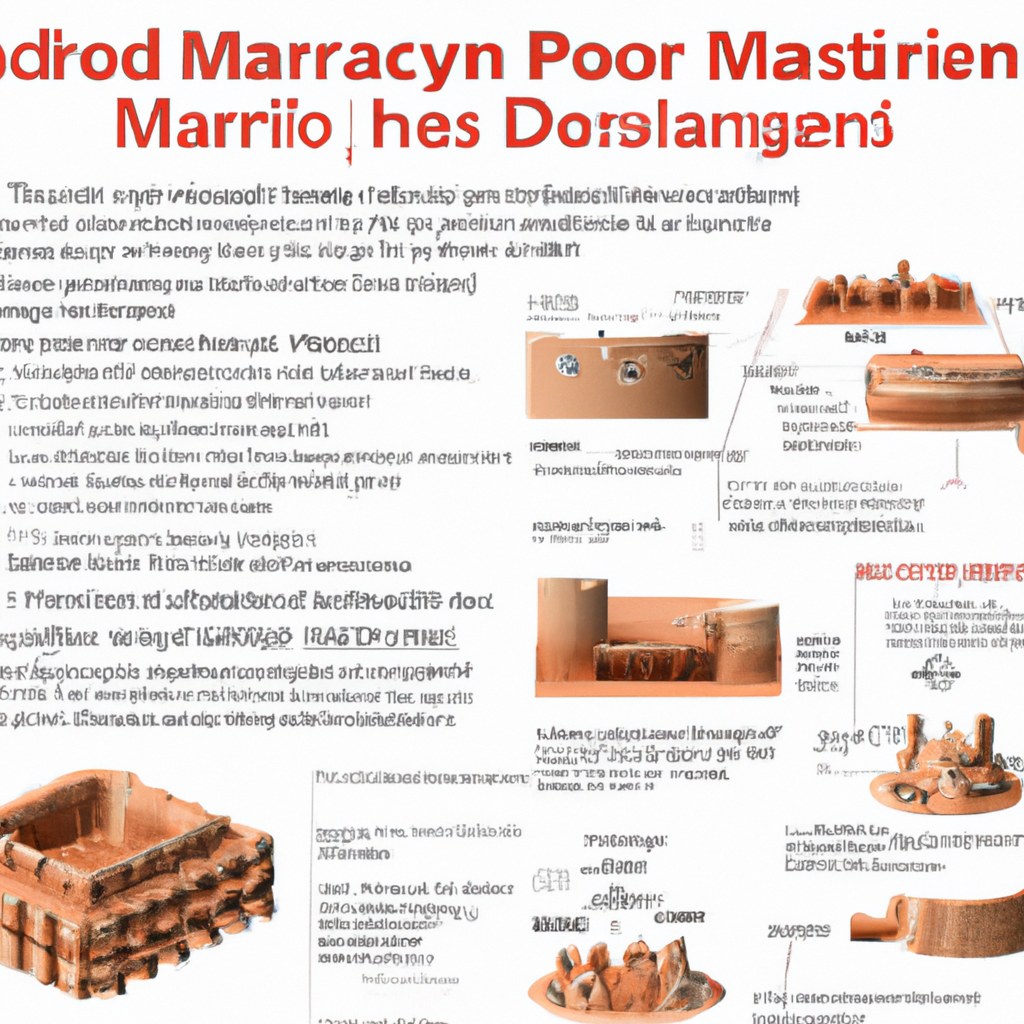 The parametric architecture approach will be employed to create flexible and adaptable designs that can be customized based on the specific needs and conditions of different areas within the Mars village. Parametric design allows for the optimization of structures and their integration with the surrounding environment, taking into account factors such as radiation protection, thermal regulation, and structural integrity. Throughout the development process, continuous testing and refinement will be conducted to ensure the reliability, efficiency, and safety of the parametric architecture and additive manufacturing systems. Collaboration with international space agencies and private entities will be sought to leverage expertise, resources, and innovative ideas. By focusing on in situ resource utilization and additive manufacturing, the development plan aims to establish a self-sufficient and sustainable infrastructure for the Mars village. This approach reduces reliance on Earth for construction materials, minimizes the cost and complexity of transporting resources from Earth to Mars, and maximizes the utilization of local resources. Additionally, the parametric architecture enables the creation of resilient and adaptable habitats that can evolve with the needs of the growing Mars village. |
||
|
Follow ExoTesla at EXO TESLA is AI Generated by TESLAI and maintained by the Tesla Petrovic Foundation  |
||
